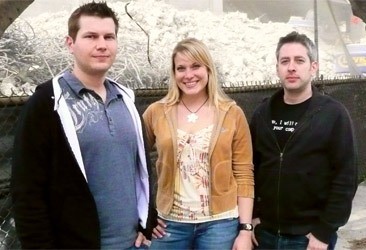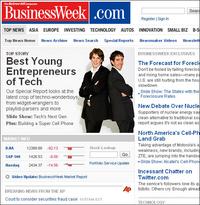 I ‘m reading about two startups this morning and I can’t help but draw a comparison.
I ‘m reading about two startups this morning and I can’t help but draw a comparison.
TechCrunch features the two-way storage widget released by Box.net. I consider Box.net is a cool company, with an interesting product, even though they are in a crowded market.
Their story is that of the classic, frugal live-in startup model: few friends get together, build the product and business day and night, live frugally but have fun in the process. (The photo to the right is from the SF Chronicle that featured several startups living the frat-house culture).
I suspect Box.net may now have real offices, having received funding from DFJ, but somehow I don’t see them spending that $1.5M on luxuries. Certainly no reserved parking 
 The other story is from Wired, about Socializr. The photo on the left shows their entire team. At first glance, a “typical” startup team – except their job titles. Toni Graham’s, in particular: Executive Assistant. No, it’s not a joke.
The other story is from Wired, about Socializr. The photo on the left shows their entire team. At first glance, a “typical” startup team – except their job titles. Toni Graham’s, in particular: Executive Assistant. No, it’s not a joke.
I had the honor (?) of discovering Socializr while they were still in stealth mode, based on a job listing for the Exec Assistant position. For a while I thought it was just a prank, but later on I confirmed they were indeed real, raising funds and actually hired Toni. While I still don’t know why a 3-person startup needs an Executive Assistant, at least I’m glad the search was thorough, and she has all the right qualifications: pretty, blonde, sings, in fact trained in opera!
I can’t really figure out what to think of this. I recall visiting some of the later stage startups, like Socialtext, JotSpot (prior to acquisition) already in decent offices,with larger teams, still no Exec Assistant to be found. What are they doing wrong? Or Atlassian, with revenues in the $16-18M range, hiring a VP Marketing for the first time, yet when you visit their San Francisco office, the President (or whoever) opens the door – no Assistant there, either.
You see, I am biased. Yes, it’s all about the product and meeting real market demand, but I admit I prefer following companies that are “likeable” in many other ways. My bias tells me when a startup’s first hire is an Executive Assistant, there is something wrong with priorities, and I don’t expect much. But of course, what do I know – and it certainly helps if your investors are your friends. 
Related post: Socializr, the “un-startup” on VC Ratings.

 Wow, this was fast. I met Koral CEO Mark Suster some time in November, when he gave me a demo of his then pre-beta Content Collaboration system. I instantly liked it, largely for it’s simplicity – hence the title of my review:
Wow, this was fast. I met Koral CEO Mark Suster some time in November, when he gave me a demo of his then pre-beta Content Collaboration system. I instantly liked it, largely for it’s simplicity – hence the title of my review:  . Koral is no more.
. Koral is no more. 



 (originally built on Mozilla) says
(originally built on Mozilla) says 





 I’ll be moderating another
I’ll be moderating another 
Recent Comments